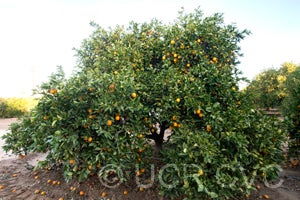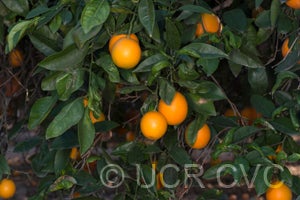Citrus sinensis (L.) Osbeck RUTACEAE
CRC 3272
PI 539609
Source
Received as budwood from Ted Frolich, UCLA Variety Collection.
Parentage/origins
Parents unknown. Originally from Spain.
Rootstocks of accession
Carrizo citrange, C-35 citrange
Season of ripeness at Riverside
February to April
Notes and observations
1986, EMN: A typical Spanish variety.
2/8/1988, EMN: Sour now, rind a bit thicker than most sweets.
2/10/1988, EMN: Fruit compared with Verna, CRC 3807. Probably identical.
Description from The Citrus Industry Vol. 1 (1967)
"Fruit medium-small, oval to ellipsoid; base commonly with faint radial furrows; apex slightly depressed; seeds few or none. Well-colored at full maturity, but regreens thereafter. Rind medium-thick, firm; surface finely pebbled. Flesh well-colored; moderately juicy; flavor sweet. Fruit holds especially well on tree with good quality and ships well. Late in maturity, but earlier than Calabrese of Italy and Valencia.
Tree slow-growing, compact, medium-small in size, and slow to bear but productive. Somewhat inclined to out-of-season flowering and production of worthless off-season fruits. Usually has a few long and narrow leaves.
This distinctive variety is of Spanish origin but is grown also in Morocco and Algeria. It is one of the latest maturing of all Mediterranean varieties and holds on the trees as well as Valencia or better but is smaller and of poorer quality.
Several clones of the Berna are recognized, one of which is characterized by greater tree vigor and round fruit of higher juice content. A selection named Alberola is said to be of superior quality. A highly similar, if not identical, variety is Peret."
Availability
Not commercially available in California.
USDA Germplasm Resources Information Network page for Berna sweet orange

